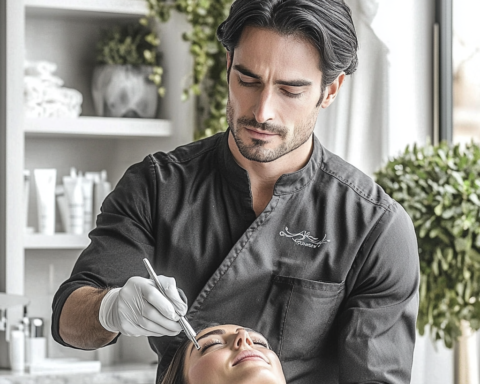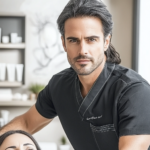How to Get Rid of Pigment Spots: Correction and Prevention Methods
Pigment spots are not just a cosmetic issue; they are a statement of your individuality and beautiful skin. In a world where every detail matters, pigmentation can become a source of anxiety. The abundance of ways to eliminate these spots—from chemical peels to laser resurfacing—can be confusing. Treating pigment spots requires not just knowledge, but also an understanding that every method has its unique characteristics and indications.
Modern individuals have access to a wide variety of products—vitamin masks, creams containing arbutin and kojic acid, as well as effective device-based treatments. In this article, we will dive deeper into the world of effective solutions and preventive measures, so your skin can shine without pigmentation traces.
Causes of Pigment Spots
Before diving into treatment methods, it’s important to understand why pigment spots occur. The main cause is an excessive accumulation of melanin—the pigment responsible for skin color. The key factors contributing to melanin accumulation include:
- Excessive exposure to sunlight, which inevitably leads to hyperpigmentation.
- Hormonal changes occurring during pregnancy or menopause.
- Post-inflammatory processes arising after acne or other skin damage.
- Age-related changes when skin loses its elasticity.
- Certain diseases and medications that affect melanin levels.
Before starting therapy, it is recommended to consult with a specialist. Treating pigment spots should begin with identifying the true cause of the spots, which will help avoid mistakes in choosing a method.
Key Treatments for Pigment Spots
Modern aesthetic medicine offers a variety of methods to eliminate pigmentation. Treating pigment spots through cosmetic procedures is becoming increasingly popular.
Laser Therapy—one of the most advanced methods—effectively addresses pigmentation without damaging surrounding tissue. Modern lasers, such as fractional and Q-switched lasers, work by selectively destroying melanin, making this method highly effective. Results can often be seen after just a few sessions, but it is essential to remember that treatments are best conducted during periods of minimal sun activity.
**Photorejuvenation (Photoepilation)**—another excellent approach—uses pulsed light to break down pigment and stimulate skin renewal. This method is suitable for various types of hyperpigmentation and can be less aggressive than lasers.
Peels, both chemical and ultrasonic, promote skin renewal by removing the upper layers, effectively combating mild to moderate pigmentation. Combining peels with other procedures such as mesotherapy, where special cocktails of vitamins and antioxidants are injected, can significantly enhance the results.
To maintain the results, particularly after professional procedures, proper home care is crucial. Products with arbutin and kojic acid can be excellent allies in the fight against pigmentation. Arbutin inhibits the enzyme tyrosinase, leading to skin lightening. This is a safe and well-tolerated ingredient that can be used for long periods. Kojic acid, on the other hand, has antibacterial properties and also suppresses melanin production.
At-Home Care: Creams and Serums for Pigmentation Correction
No salon procedure will be effective without proper at-home care. Regular use of specialized products containing arbutin, kojic acid, as well as vitamins C and B3, can genuinely speed up the correction process and prevent the appearance of new spots. For example, vitamin C not only brightens but also strengthens the skin, while niacinamide helps block melanin synthesis and enhances the skin's protective functions.
Don’t forget to protect your skin from ultraviolet radiation year-round with quality sunscreen featuring SPF 50+. This is especially important after peels and laser treatments, which can temporarily increase your sensitivity to the sun. For effective results, it's necessary to use products with a comprehensive action that include several lightening components.
Prevention: Simple Rules Against New Spots
To prevent the reappearance of pigmentation, it is important to pay attention to prevention. Use sunscreen daily, even on cloudy days, and try to avoid sun exposure during peak hours. Wearing hats and long-sleeve clothing can also significantly reduce risks.
Take care of your hormonal balance and regularly have check-ups with a dermatologist. Monitor your skin condition and consult a specialist if you notice changes, such as rapid growth in size of a spot or changes in its shape.
When to See a Doctor
Consulting a doctor becomes critically important if you notice any change in your pigment spots—rapid growth, itching, peeling, or pain. Irregular edges and unusual colors (such as black or blue) also require the attention of a specialist. Self-treatment in such cases is inadvisable.
Conclusion: A Professional Perspective on Pigment Spot Correction and Prevention
Skin pigmentation is not just an aesthetic issue but also reflects your internal state. Treating pigment spots involves an individualized approach and a thoughtful choice of methods based on the latest achievements in aesthetic medicine. Take care of your skin, use scientifically-backed methods, and trust professionals—and let your skin always be your pride and calling card.
Modern techniques can truly work wonders when it comes to correcting pigmentation. Remember, a comprehensive approach to care and prevention will help you permanently forget about pigmentation issues, allowing your skin to radiate health and youth.
Do you want to keep up to date with the latest news about plastic surgery? Subscribe to my Telegram channel: https://t.me/By_Staisupov_ENG
Do you like to watch videos? More useful information is available here (the channel is in Russian, but you can always turn on auto-titles): https://www.youtube.com/@staisupov
All the results of plastic surgery can be found here: https://staisupov.com/results







